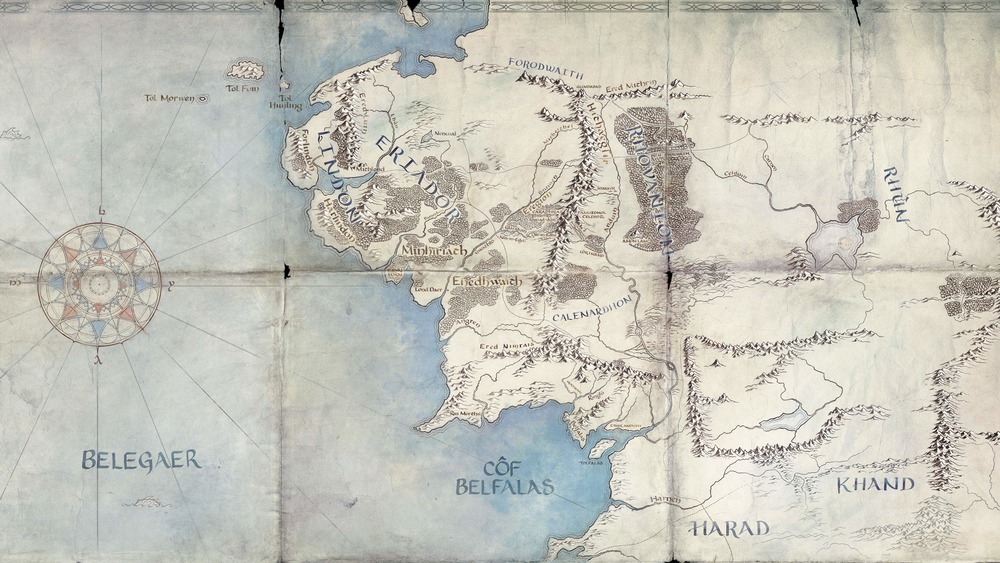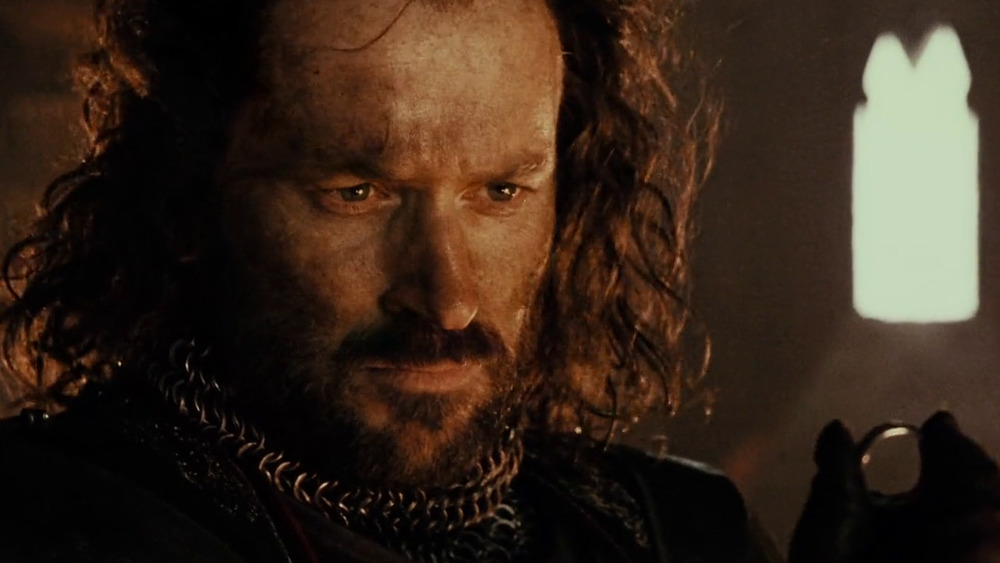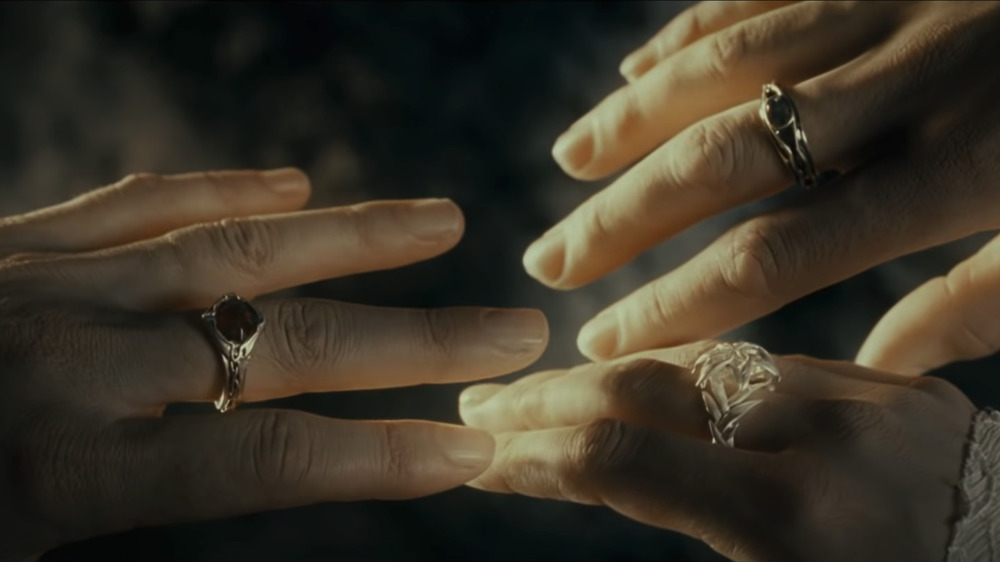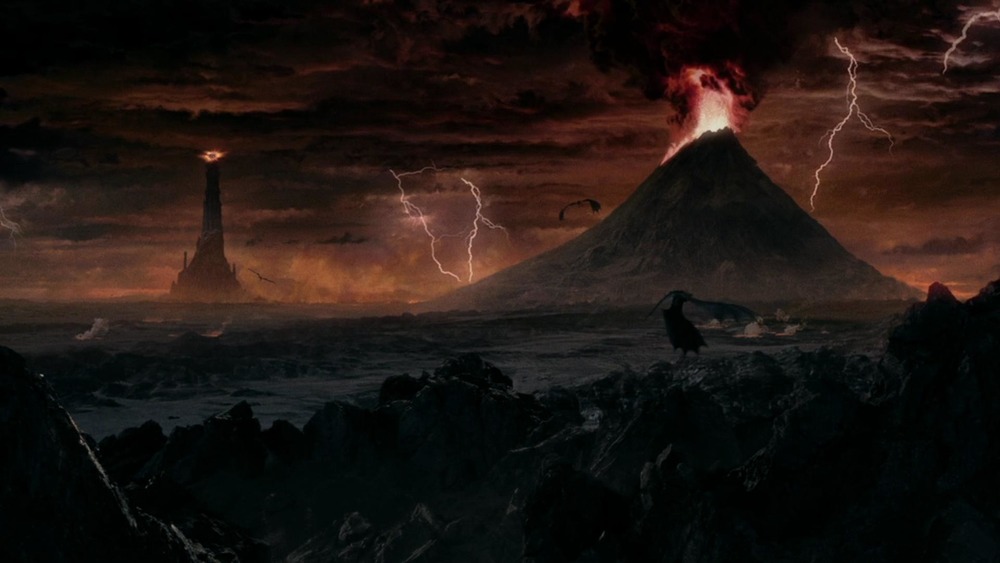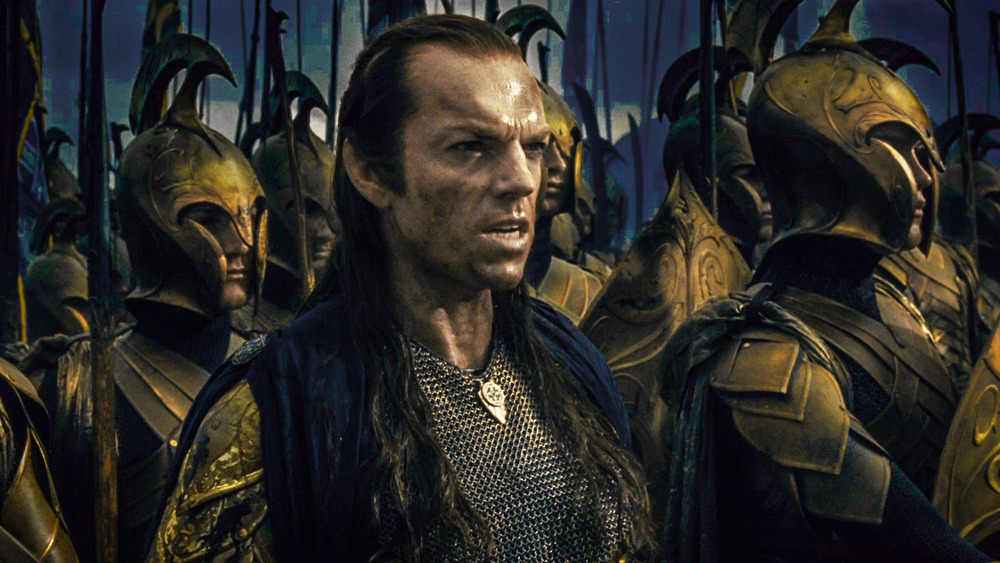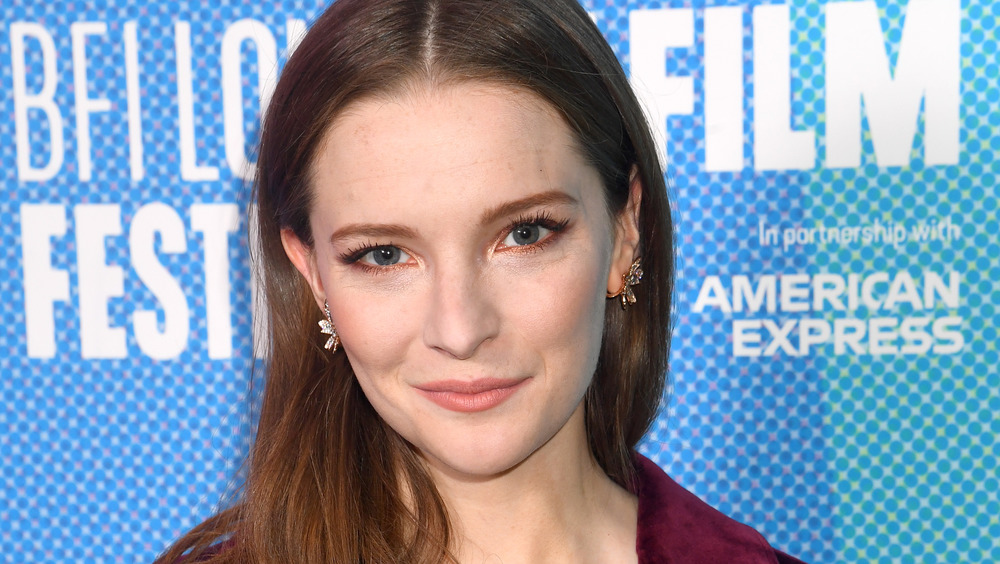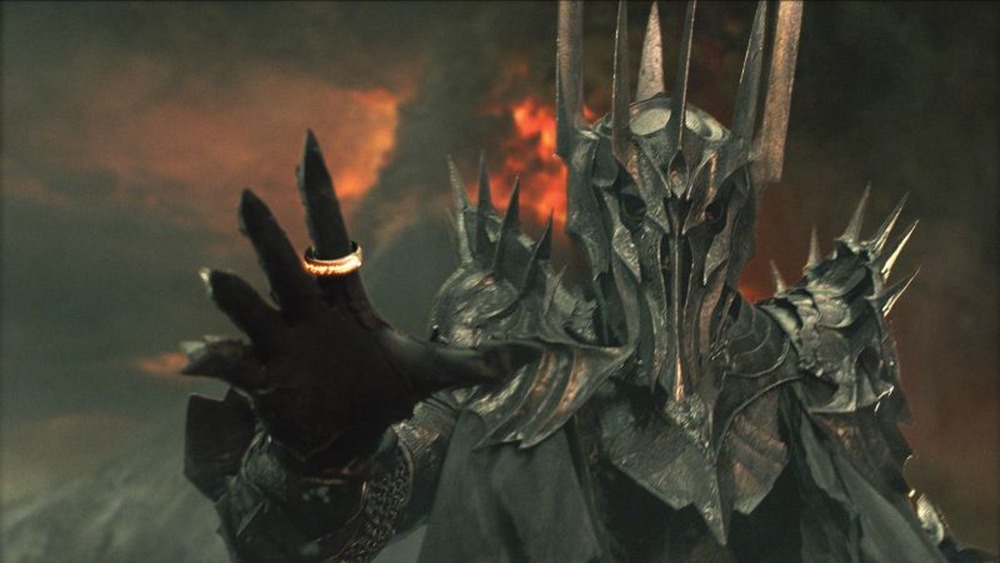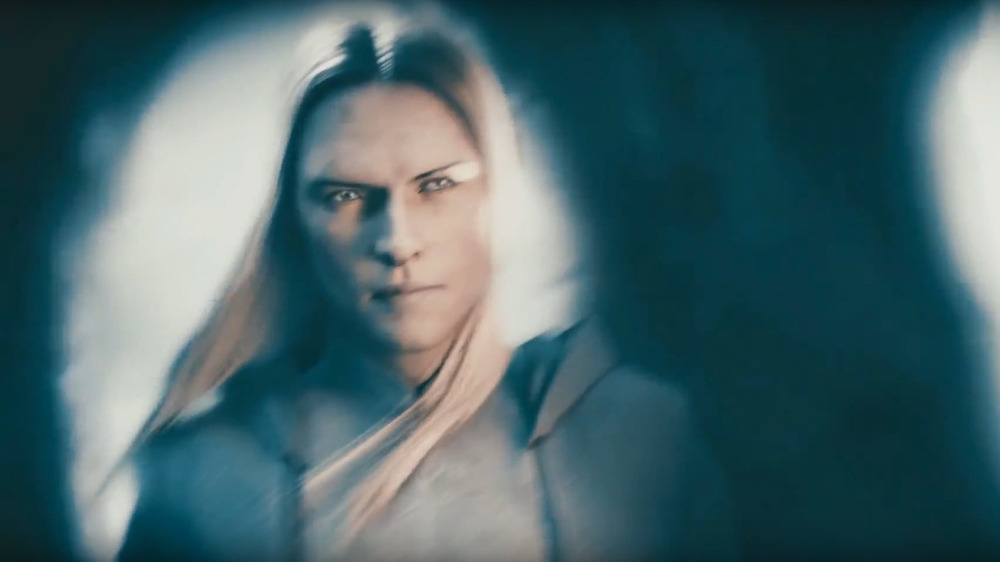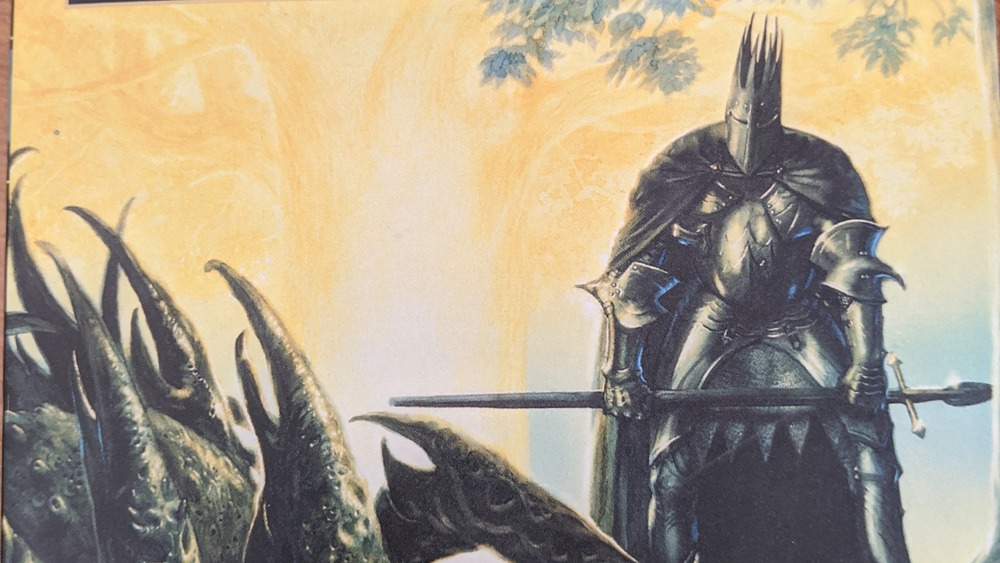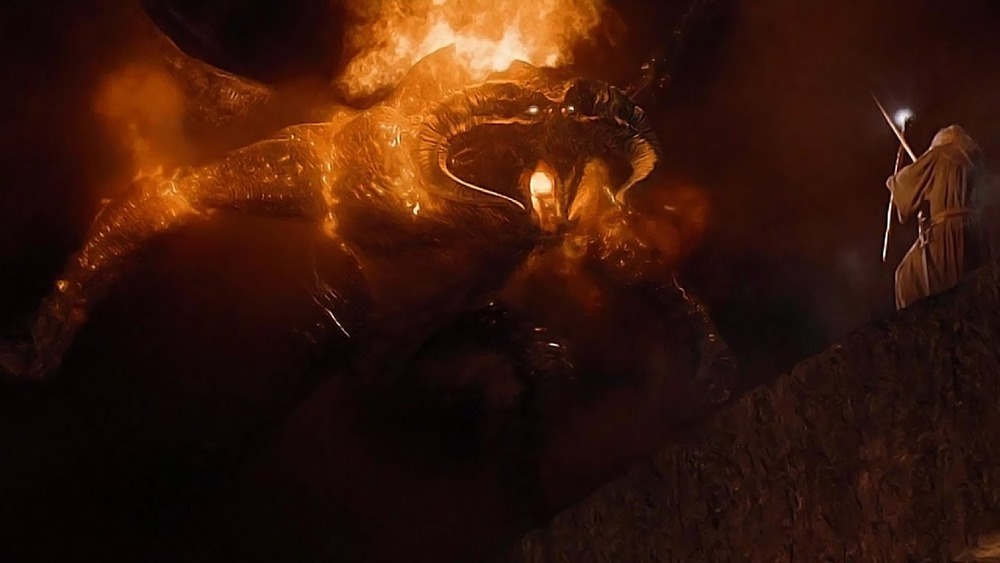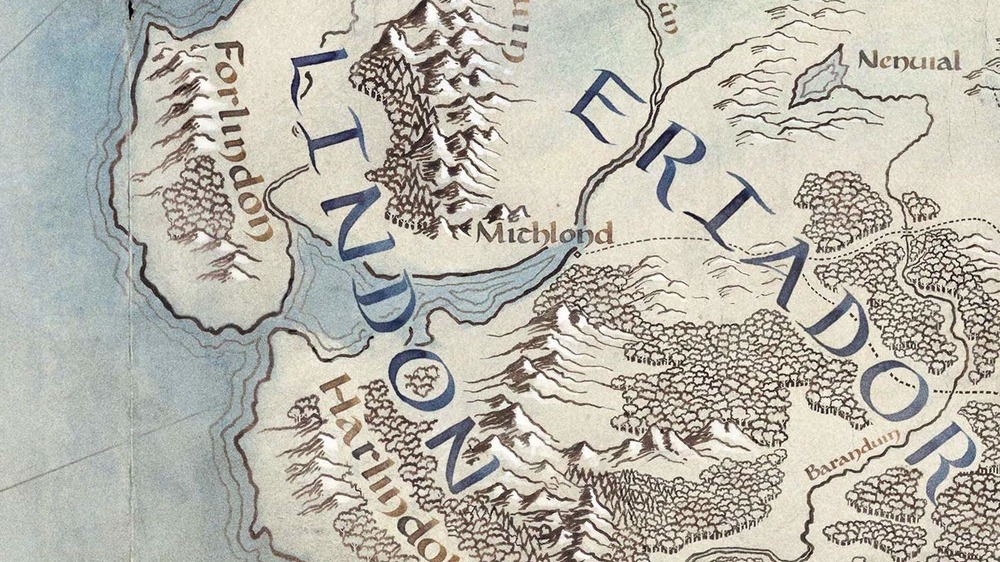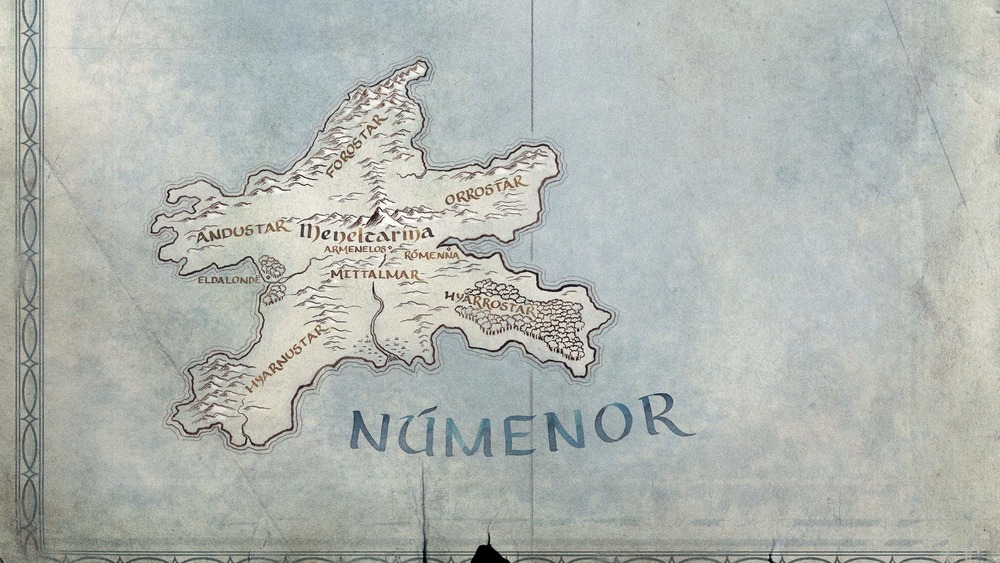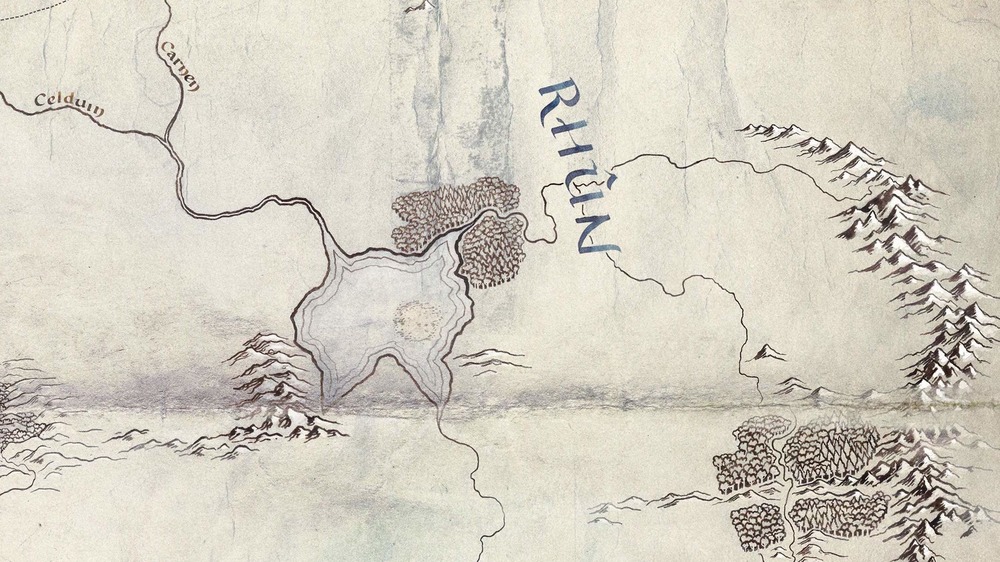Hints, Rumors, And Confirmations From Amazon's Lord Of The Rings Synopsis Leak
Amazon's Middle-earth show has been buzzing on the internet for years now — but not necessarily for reasons that would make J.R.R. Tolkien proud. Casting names, filming locations, and ridiculously oversized budgets are the primary items that have kept the gargantuan project in the spotlight thus far. Sure, at one point along the way, Amazon Studios did release a series of maps on their Twitter account teasing the age that the show will be set in. But as far as genuine content goes, we've had very little else to go on — until now.
Less than two weeks into 2021, TheOneRing.net released an exclusive spy report that claimed to include the official synopsis for the long-awaited series. In the wake of the leak, most sites jumped on the information, particularly highlighting a clear-as-day hint that we're going to see Sauron again. The truth is, though, the brief bit of new info doesn't just confirm that the villain of The Lord of the Rings will be showing up again — it's also laced with a ton of confirmations, fresh rumors, and even some new hints to keep that spark of excitement alive in Tolkien aficionados everywhere as they wait for the show to finally air.
We decided to dig a bit further into the context of each part of the synopsis, breaking it down and fully fleshing out just what we're going to get when this mammoth undertaking finally hits everyone's home theaters. These are all the hints, rumors, and confirmations from Amazon's Lord of the Rings synopsis leak.
The show's definitely in the Second Age
Okay, this one's been obvious for a while now. But before you skip ahead and look at the other takeaways, let's consider the show's setting. In March of 2019, Amazon Studios released a series of maps via its Lord of the Rings on Prime Twitter feed. These culminated with a final image that clearly showed Middle-earth during the Second Age of Tolkien's writings. It even came with the little confirmation note "Welcome to the Second Age."
This set the internet on fire — and with good reason. The Second Age is loaded with great stories and is a largely under-explored area of Tolkien's legendarium. That said, it's also freaking 3,500 years long. In other words, simply saying that you're doing something "from the Second Age" kind of feels like Ken Burns stating that his next historical documentary is going to be set somewhere between the Ancient Greek Olympics and the 21st century.
Fortunately, along with confirming the Second Age, the synopsis also mentions that the show will begin "in a time of relative peace." This is important, as the second half of the Second Age, in particular, is loaded with action. While the show could technically be referring to a lull in said action, chances are it's referencing the earliest part of the age, specifically just after the original Dark Lord Morgoth fell and his second in command, Sauron, is still finding his sea legs as the new boss.
Hinting at the Rings of Power
Along with Sauron and the Second Age, there's one other major hint that quickly resonated with fans of The Lord of the Rings books and movies. This comes in the second sentence, where it reads that the show will "take viewers back to an era in which great powers were forged..." Sound familiar? Yeah, there's a 99% chance that this is talking some pretty nifty overpowered jewelry — and we're not just talking about the One Ring, either.
All of the major Rings of Power were forged roughly halfway through the Second Age. This includes nine for the Men that eventually become the Ringwraiths, seven for the Dwarves, three for the Elves, and one for the Dark Lord. Of course, when they're originally forged, they aren't divvied up in that way yet. They're all initially owned by Elves, who are able to create most of the magic baubles with the help of their new friend Sauron — yes, friend. It's a whole thing.
While it's almost certain that the Rings of Power are the "great powers" being discussed here, it should also be pointed out that it could be talking about something else: alliances. The Third Age is largely defined by the Free Peoples of Middle-earth fighting Sauron in isolated pockets. However, the Second Age actually features several major unions and collaborations between the races of Elves, Men, and Dwarves, in particular. The end of the age even has the famous "Last Alliance" which confronts Sauron and cuts the Ring from his finger.
Familiar kingdoms on the rise
One phrase from the synopsis that jumps out at first glance is the line "kingdoms rose to glory." While there are many strange new places that the Amazon show will doubtless spend time exploring, several of these rising kingdoms will be quite familiar — in name, at least.
For instance, Lothlorien, Khazad-dûm, the Woodland Realm in Mirkwood, Rivendell, Gondor, and Mordor are all present in the Second Age. However, most of them are in their infancy, and all of them grow and evolve.
Galadriel visits her future kingdom for the first time during the Second Age. Legolas' grandfather, Oropher, establishes a refugee Elven Kingdom in the heart of Mirkwood. The Dwarven mansion of Khazad-dûm is already ancient when the age begins, but it becomes particularly important during the early years of the age as well.
Gondor is founded toward the end of the Second Age, and Elrond also founds Rivendell halfway through the age in direct defiance of a victorious Sauron. And the Dark Lord himself? Early on, he carves out a nice corner of the map to serve as his chief base of operations for the next age and a half. The name of this dangerous new region? Mordor.
New kingdoms rising and falling
The line "kingdoms rose to glory and fell to ruin" isn't just referencing places that a Third Age fan might already be aware of. The Second Age also features several completely new kingdoms — most of which are really, really important to the story.
For instance, Númenor is an extremely powerful island nation of Men that rises and falls during this age. It's located off the southwestern coast of the mainland. Lindon and Eregion are a pair of powerful Elven nations located in the northwestern portion of the continent — i.e. around the area where the Shire, Bree, and the gates of Moria are located later on in the Third Age. Lindon is an Elvish super-hub of activity, and Eregion is where the Rings of Power are forged, making it public enemy number one for the Dark Lord.
For a Third Age audience primed with names like Gondor, Erebor, Rohan, and even the Shire, these powerful kingdoms are going to make the Second Age feel a bit foreign at first glance. However, it doesn't change the fact that they exist on the same classic map that we're all used to; given enough time, Amazon can weave their stories into the larger cinematic Middle-earth narrative.
Who are these unlikely heroes you speak of?
The synopsis also states that "unlikely heroes were tested." This is an interesting point for the Amazon show. It's curious that the studio would take the time to highlight that its heroes will be "tested," particularly since we have absolutely no idea who said heroes will be.
So far, the major characters have largely remained shrouded in mystery. Sure, hints have come out here and there. For instance, Ian McKellen said he was up for reprising his role as Gandalf (even though the character isn't seen in his "wizard" form until the Third Age.) On the flip side, Elrond alumni Hugo Weaving has made it abundantly clear he has no plans to come back. Nevertheless, the only solid actor-to-character connection that leaked in the first few years of production was Morfydd Clark's casting as a younger Galadriel.
As if the lack of information wasn't bad enough, other leaks have added to the confusion by throwing around unheard-of character names like Oren, Beldor, and Tyra. It was initially guessed that these were fake names disguising well-known characters. However, the synopsis states that "the series follows an ensemble cast of characters, both familiar and new..." These could very well be the actual names of characters made up for the show.
The new leak doesn't offer up a definitive answer for what heroes we'll be seeing. However, it does make it clear that the show will be blazing its own, non-Tolkien trail with at least some of the heroes, whether the fans like it or not.
Sauron's role
Have you ever wondered why, in The Lord of the Rings, it's pointed out that the One Ring would allow Sauron to cover all of the lands in a "second" darkness? What about the first darkness? When was that? Why, in the Second Age, of course.
In the middle of the synopsis, we find the harrowing line "hope hung by the finest of threads, and the greatest villain that ever flowed from Tolkien's pen threatened to cover all the world in darkness." These words highlight the likelihood that Amazon's show will indeed be heading straight into the belly of the beast by following the Dark Lord Sauron during his initial rise to power.
This will lead to some of his greatest victories and the first time that he covers nearly the entire continent of Middle-earth in darkness. This doesn't just make him a perfect central villain to the plot. It also allows the studio to divest him of the one-dimensional villain persona that he has throughout The Lord of the Rings. Instead, they'll get to introduce fans to a much more interesting Second Age version of the character.
Annatar, the sexy Lord of Gifts
The fact that Sauron is clearly highlighted in the synopsis only confirms what was already widely hoped and believed would be the case. Fans have long thought Sauron would be central to the plot. What this confirmation also means, though, is that we're likely going to see "sexy Sauron" too.
If you're wondering how the flaming eyeball from Peter Jackson's films could come across as attractive in any way, don't worry. We're not talking about a bizarrely romanticized ocular organ here. (Besides, Tolkien never meant for his villain to literally look like a spotlight-eyeball hybrid anyway).
This is thousands of years before the Lord of the Rings. In fact, the show takes place so much earlier that we're talking about a point in time when the Dark Lord — who is primarily spiritual in nature — could still put on an attractive physical form to be seen by those around him. In the Second Age, he does this for a long time, masquerading as "Annatar, the Lord of Gifts." This allows the Dark Lord to mingle with the Elves and temporarily gain their trust. While it doesn't make him a hero by any means, this twist does add a fascinating level of misdirection to a villain typically associated with brute force.
Re-emergence of evil?
Toward the end of the synopsis, it states that the series' heroes will "confront the long-feared re-emergence of evil to Middle-earth." At first glance, this doesn't seem to jive with the whole "first darkness" theme that the show is clearly setting up.
However, if one turns to the source material, they will quickly find that Sauron himself is actually little more than evil's second act in Middle-earth. He only shows up as the Dark Lord after his master, Morgoth, is defeated at the end of the First Age of Middle-earth history. This is the stuff that you can find in Tolkien's ultra-epic The Silmarillion. Confusing, convoluted, and cobbled together after the author's death, The Silmarillion traces events from the beginning of Middle-earth history. Throughout the entire first portion of the story, the primary antagonist is a badass dude named at various times either Morgoth or Melkor.
The First Age ends with Morgoth's catastrophic defeat, which breaks part of the world and sends the original Dark Lord into eternal imprisonment. His servants flee... including his chief lieutenant, Sauron. Eventually, Sauron gets a backbone again and begins plotting how to take up his master's mantle — an event that we're betting is exactly what the writers had in mind when they worked "re-emergence of evil" into the synopsis.
Hinting at the Balrog?
Sauron is clearly the biggest baddie in both the Second and Third Ages. There's no question. However, that doesn't mean he's the only creature lurking around looking to cause some mischief. Take, for instance, the Balrog from The Fellowship of the Ring.
The fiery demon isn't just a terror to all and sundry. It's also fiercely independent. In fact, when Gandalf talks about his encounter with the Balrog in The Two Towers, he mentions that "Far, far below the deepest delvings of the Dwarves, the world is gnawed by nameless things. Even Sauron knows them not." Whether he's directly referring to the Balrog or not, the point is well taken. There are many evil creatures in Middle-earth that don't particularly owe their allegiance to the Dark Lord. Even Shelob is discussed as a being that Sauron isn't interested in subduing or dominating.
With all of that said, the last sentence of the synopsis starts with the line "From the darkest depths of the Misty Mountains." The choice to use the words "darkest depths" forces us to look deeper than the well-lit halls of Khazad-dûm — to a Balrog, perhaps? The only problem with this theory is that the Balrog doesn't actually do much in the Second Age. It likely flees after the fall of Morgoth and hides under the mountains, but it isn't "woken up" by the Dwarves until well into the Third Age. It will be interesting to see if and how Amazon handles the character in its show.
What and where is Lindon?
One of the more curious parts of the synopsis is the brief mention that the story will span "to the majestic forests of the elf-capital of Lindon." This naturally leads to the question: what and where is Lindon? The short answer is that Lindon is a powerful Elven nation that exists throughout the Second Age.
The long answer is that Lindon is a complicated area that overlaps with a ton of different Middle-earth storylines. The land is located in the far northwest corner of Middle-earth. It sits right next to the area that eventually becomes the Shire. It's also the place where the Grey Havens is located and where Frodo and Bilbo sail off into the West at the end of The Return of the King.
In the Second Age, Lindon is a powerhouse of a kingdom. It initially creates a sense of stability for the good guys living in Middle-earth. Later on, its role shifts to one of a beacon of hope as the varying events of the age play out. The kingdom is ruled by the Elven King Gil-galad. Elrond spends time there before he heads off and establishes Rivendell. Many other Elven kingdoms start with folks in Lindon migrating to colonize other areas, too. Lindon is also a primary force in creating crucial alliances with Men and other Elves, and ultimately it provides much of the muscle to topple Sauron at the end of the age.
What about Númenor?
The last sentence of the synopsis also states that the show will go "to the breathtaking island kingdom of Númenor." The fact that the island nation of Men will be involved in the show was practically a forgone conclusion from the first moment the Second Age was mentioned. Nevertheless, knowing that the nation will get its fair share of the spotlight is really good news for fans of oversized dramatics and adventure.
Everything about Númenor is epic. The Valar — the guardians of Middle-earth — gift the island nation to its inhabitants early in the age and the Men of Númenor continue to flourish there for centuries. Their kings — a royal line that eventually leads to none other than Aragorn himself — are also given extraordinarily long lives. The Men of Númenor eventually get tangled up with events on the mainland and become Sauron's chief enemy for a time. When this happens, they unexpectedly find that the sly Dark Lord is devilishly sneaky, even in defeat.
Over the course of the Second Age, the Númenóreans go from newbie wunderkinds to ancient allies. In that process, their nation experiences extreme triumph and peace as well as intense tragedy and sorrow. Hands down, they're going to be one of the best parts of this series.
Will they go where even Tolkien dared not tread?
One of the last things in the synopsis is the news that the kingdoms and characters will go "to the furthest reaches of the map." This is an interesting statement, as it can basically mean one of two things.
On one hand, this could be a veiled reference to the Blessed Realm. This is the land that lies hidden in the West. It's where the Elves (and a few select mortals like Frodo, Bilbo, Sam, and Gimli) sail when they're tired of Middle-earth. The immortal continent and its blessed dwellings are focal points of the earliest part of the Silmarillion. However, at the end of the First Age, both are hidden from the world and don't come into the story much after that. Even so, the Men of Númenor do live in sight of the Blessed Realm, although, as mortals, they're forbidden to go there.
On the other hand, the line could be talking about the eastern regions of Middle-earth. These are areas of the map that were hardly ever explored, even by Tolkien himself. However, they are areas where Sauron is regularly active, recruiting armies and intimidating the inhabitants. If the Amazon show heads in this direction, they will truly be blazing a trail so unique that even the creator of Middle-earth himself won't have much source material to help them out.
